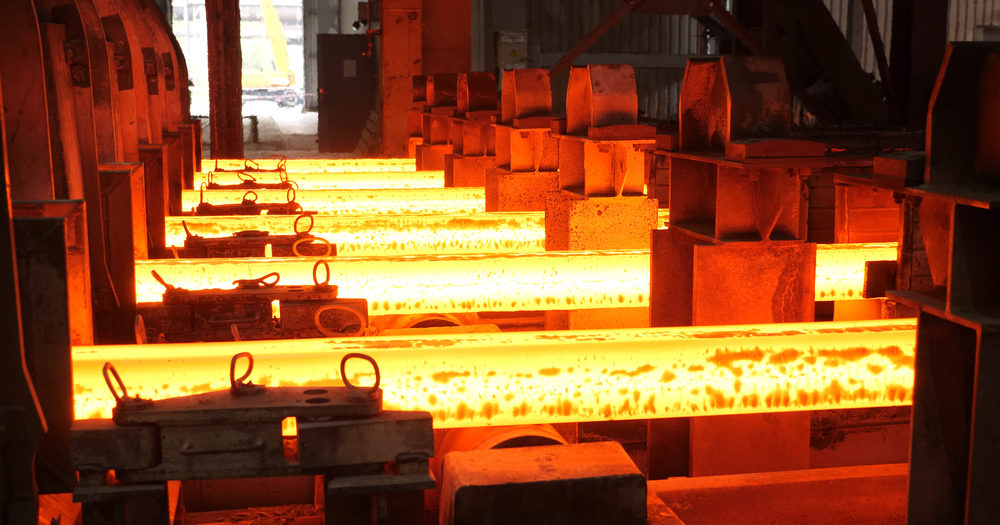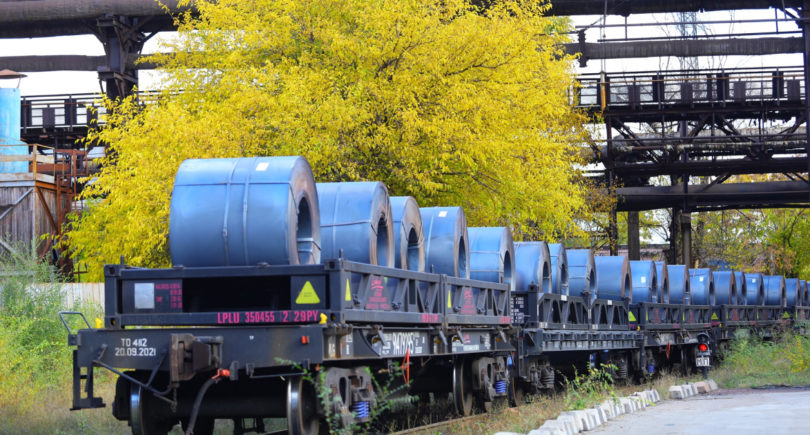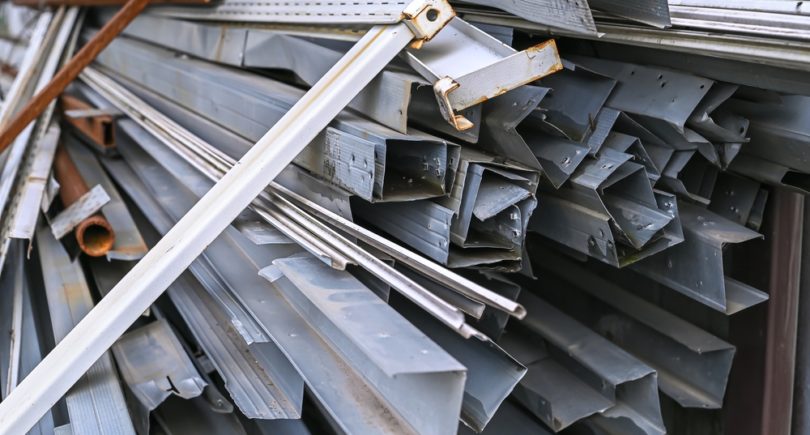
Posts Industry Ukraine’s iron and steel industry 4047 10 April 2024
Supporting export potential, staffing and ramping up production remain the main issues for Ukrainian steel sector
The material was prepared on the basis of GMK Center research for the 95th Session of the OECD Steel Committee – available for download at the link.
Before the full-scale invasion of the Russian Federation, the Ukrainian iron and steel complex provided more than 10% of the country’s GDP, including supply chains, and accounted for more than 30% of pre-war exports of goods (now this figure has fallen by half). At the moment, steel industry has a wide range of problems – from lack of personnel and problematic logistics to certain trade restrictions and inability to significantly increase capacity utilization.
Unclear prospects
As the hostilities progressed, the Ukrainian steel industry suffered huge losses. Until 2014, there were twelve steelmaking enterprises in the country. Now only six remain, and only five are still in operation.
Before 2014, Ukraine’s total nominal steelmaking capacity was 42 million tons, in 2021 it was 27 million tons, now it has fallen to 17.8 million tons. After the start of the full-scale invasion, the Mariupol steel mills were occupied by Russian military forces. The prospect of their return under Ukrainian control remains uncertain in the foreseeable future. The steelmaking capacities at Dnipro Metallurgical Plant (DMZ) are idle. The enterprise is now operating on a tolling scheme, and the prospects for its full launch, especially during the war, are dim.
Currently, only 5 of Ukraine’s 13 available blast furnaces are in operation, as well as two electric arc furnaces at Dneprospetsstal and Interpipe Steel.
The plants that continue to operate have a rather high capacity utilization rate in the military conditions, and the potential for its increase is low. The exception is ArcelorMittal Kryvyi Rih, Ukraine’s largest steel mill. Now only one blast furnace out of four is in operation here. Another blast furnace is scheduled to be launched in April 2024, which may increase capacity utilization from the current 25% to 50%.
Ukraine managed to increase steel production after the shock of the first year of the full-scale war. At the end of 2023, crude steel production amounted to 6.2 million tons (-0.5% compared to 2022). However, these volumes are 70% less than the pre-war level. But as for the monthly dynamics of steel output, there has been no progress for more than a year – monthly production remains at 550 thousand tons.
Ukraine’s steelmaking volumes are expected to rise to 7.2 million tons in 2024 due to the launch of a blast furnace at ArcelorMittal Kryvyi Rih, but problems in the energy system due to strikes on generating capacity could worsen this forecast. However, this is probably close to the ceiling of the industry’s current capacity. There are now a number of serious factors limiting production growth.
Personnel shortage
The first of these problems is the lack of personnel. Before the war, the Ukrainian steel industry and related industries employed more than 0.5 million people. The iron and steel sector was the largest employer and provided the population with well-paid jobs, deterring labor migration.
In the conditions of a full-scale war, 15% of the personnel of all major metallurgical enterprises have already been mobilized. However, Ukrainians are not in a hurry to fill the vacancies at large plants – here the procedures of personnel records are transparent and new workers can be mobilized.
Internal migration also has a negative impact on the ability to fill the shortage of personnel. Steel mills are located close to the front line, and the cities where they are located are under the aggressor’s daily attacks. This forces people of working age to leave dangerous regions together with their families.
Mauro Longobardo, CEO of ArcelorMittal Kryvyi Rih, estimates that in 2024, due to layoffs and mobilization, the company may need to close 3 thousand vacancies, which require people who are ready to start working immediately. But to find three thousand trained metallurgists in Kryvyi Rih is a difficult and non-trivial task. And the problem of personnel shortage is already affecting today, limiting the industry’s growth potential in the future.
Tax problems
Ukrainian steelmakers also call for addressing key problems of domestic taxation – so business could improve efficiency in times of war. The problem, in particular, was raised by Metinvest CFO Yuliya Dankova. She reminded that Ukraine has long been discussing the possibility of introducing tax consolidation, but it has fallen out of focus for a while. In the current realities, the issue should be revisited.
According to Dankova, it is also necessary to consider the problem of tax duplication. Companies would be able to channel the freed up resource into investments and job creation. In addition, it would stimulate budget revenues in the form of import VAT, customs duties, increase in profit tax.
Business has some problems with VAT reimbursement. The financial director of Metinvest noted that in general the mechanism works, but some weighty issues are not solved: some of the company’s counterparties, from whom services or goods are purchased, are considered risky by the tax authorities. In the conditions of military operations, the importance of the problem grows as it affects the working capital of the group.
Instability of the maritime corridor
Ukrainian exporters have high hopes for the Ukrainian sea corridor, but it remains unstable.
Iron and steel products are the second by share in total exports by the Ukrainian sea corridor. In particular, in December 2023 last year, 1.2 million tons of ore and 200 thousand tons of metals were exported through this route. During half a year of its operation (August-December 2023), according to GMK Center estimates, at least 46 vessels with 2.6 million tons of ore and 653 thousand tons of metal products left Odessa and Yuzhny ports. Among them were bulk carriers, blocked in the seaports since February 24, 2022.
The current mechanism is fundamentally different from the Black Sea Grain Initiative, when the passage was agreed upon by all participants. Now there are no agreements, and accordingly, the risk level is higher.
Without understanding the prospects of future sales and guarantees of stability of sea logistics, for example, it is difficult to make decisions, for example, on investments of $10-20 million to launch a blast furnace. High risks also lead to a serious increase in the cost of product transportation for Ukrainian steelmakers. For example, in October 2023, freight rates through the sea corridor were four times higher than pre-war levels, and in January 2024 – twice as high. At the same time, each case differs from the previous one.
Competition with Russian products
Before the full-scale war, the traditional markets for Ukrainian steel exports were MENA, Turkey and Africa. However, now many destinations have been closed for Ukrainian steelmakers, and selling steel to markets where the Russian Federation is present has become a virtually impossible mission.
Exporters of russian steel products get an advantage due to low non-market energy prices, while in Ukraine these prices are close to European ones. In addition, they do not have logistical problems like Ukrainian steelmakers.
It is also important that Russian products continue to remain on the EU market. In December 2023, the European Commission postponed the ban on imports of slabs from Russia, and in the 12th package of sanctions, the bloc extended quotas on them for another four years. As a consequence, Russian rolling mills in Belgium, which import slabs from Russia, are gaining a price advantage and putting pressure on the market. At the beginning of March 2024, they were offering hot rolled coil (HRC) at €680/t, while other European producers in the EU were offering it at €720/t. This leads to distortion of competition and losses for European steelmakers.
Trading restrictions and CBAM
Another constraint for Ukrainian steel industry is trade restrictions. In 2022, the EU removed Ukraine from the quota system and anti-dumping measures. This was an important step that supported the domestic steel sector. But it is important to extend this decision for the next year. Otherwise, Ukrainian mills will fall under the «other countries» quota for such commodities as hot-rolled coil. They will be forced to compete with Asian suppliers, who fill quotas literally in one day.
The United States has temporarily suspended Section 232 for Ukrainian steel until June 2024 and the future of this regime beyond June is still unknown. However, seven anti-dumping measures against steel products from Ukraine remain in effect in the United States, blocking any domestic exports. At the same time, the easing of the trade regime for our country by the United States will create more opportunities for local producers to finance the Ukrainian budget.
Before the full-scale invasion, steel industry was the flagship of investment processes in the country – it accounted for a third of industrial capital investments. However, during the war, the industry lagged behind in this matter. Today, the importance of investment is higher than ever amid the prospect of implementing the European carbon border adjustment mechanism (CBAM). But with the urgent need to invest in reducing their carbon footprint, Ukrainian steel mills are forced to focus on the struggle for existence.
According to GMK Center’s calculations, the CBAM will result in the loss of 1.6 million tons of Ukrainian exports of long products and semi-finished products to the EU, as well as 1.4 million tons of pig iron. Domestic business expects that Ukraine will receive the status of a country excluded from the CBAM with a transitional period. It is also important that the status of associate member or quasi-membership in the EU will allow Ukraine to have access to European funds for financing decarbonization projects.
Domestic demand
The domestic market is now able to provide only limited support to the industry. In 2023, steel consumption in Ukraine rose to 3.3 mln tons from 2.1 mln tons a year earlier, but there is no further potential for growth. Consumption of steel products in Ukraine is expected to grow by 10% y/y in 2024, but in physical terms it is only 300 thousand tons. These volumes will not have a noticeable impact.
At the same time, the country has a huge need for infrastructure renewal. Amid this, the long-term growth potential of steel consumption is up to 5 million tons. Therefore, international financial assistance aimed at financing recovery projects is also very important to support the steel sector through orders for steel products.
Steel industry has been and remains a basic industry for the Ukrainian economy. Its restoration will be a significant contribution to our country’s defense capability and economic prospects. The challenges facing Ukrainian steelmakers mean another difficult year for them, and in many cases require the attention and support of the Ukrainian authorities and international partners.




